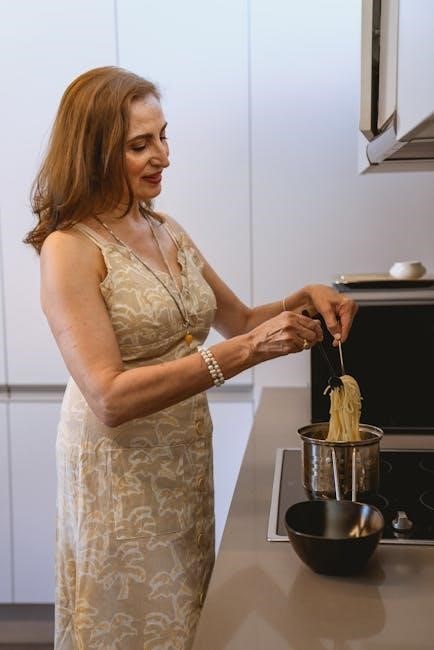
PIP assessments evaluate daily living skills, including food preparation, focusing on tasks like peeling, chopping, and cooking. This section provides guidance on how to describe your abilities accurately.
Overview of PIP and Its Relevance to Daily Living Activities
PIP (Personal Independence Payment) is a UK benefit for individuals with disabilities or long-term health conditions, assessing how these affect daily living and mobility. Food preparation is a key daily living activity evaluated under PIP, focusing on tasks like peeling, chopping, and cooking. The assessment considers whether claimants can perform these tasks independently, with aids, or if they require assistance. Understanding PIP’s relevance to daily living activities is crucial for claimants to accurately describe their challenges and demonstrate their eligibility for support. This section provides insights into how PIP evaluates food preparation and its impact on daily life, helping claimants navigate the application process effectively.
Understanding Activity 1: Preparing and Cooking Food
Activity 1 of the PIP assessment focuses on a claimant’s ability to prepare and cook food, evaluating tasks like peeling, chopping, and heating. It assesses whether individuals can perform these tasks independently, with aids, or if they require assistance. The activity does not measure culinary skills but rather the impact of health conditions on daily food preparation. Claimants are expected to describe their ability to prepare a simple meal, such as boiling potatoes or frying meat, and explain any challenges they face. This activity is crucial for determining the level of support needed, ensuring accurate scoring and fair assessment of daily living capabilities.

Example Answers for PIP Food Preparation Questions
Example answers provide guidance on describing challenges in food preparation, such as peeling, chopping, and cooking, helping claimants accurately convey their difficulties and needs.
Example 1: Difficulty Preparing Meals Due to Health Conditions
For instance, someone with rheumatoid arthritis may struggle to peel vegetables or grip utensils due to pain and limited dexterity. They might need adaptive tools or assistance to chop ingredients safely. A person with chronic back pain could find bending or standing for long periods challenging, requiring frequent breaks. Conditions like arthritis or fibromyalgia may slow meal preparation, making tasks like opening packaging or stirring food difficult. These examples illustrate how health conditions can significantly impact one’s ability to prepare meals independently, emphasizing the need for aids or support to complete these tasks effectively.
Example 2: Specific Tasks Involved in Food Preparation
Food preparation involves tasks like peeling, chopping, boiling, and opening packaging, which are essential for creating a simple meal. For example, peeling potatoes, chopping vegetables, or opening a tin of sweetcorn are fundamental steps. Claimants may need to explain how their condition affects these tasks. Someone with arthritis might struggle to grip a knife for chopping or open tight packaging. Others with mobility issues might find boiling water or using a microwave challenging. It’s important to detail how each task is impacted, such as needing assistance or using aids. This specificity helps assessors understand the level of difficulty and allocate the appropriate points for support.
Example 3: Impact of Disabilities on Cooking Abilities
Disabilities can significantly hinder cooking abilities, affecting both preparation and safety. For instance, visual impairments may cause difficulty in measuring ingredients or recognizing when food is cooked. Physical disabilities, such as limited dexterity, can make using utensils or appliances challenging. Mental health conditions like anxiety may lead to avoidance of cooking due to fear of accidents. Sensory sensitivities might make handling certain textures or smells unbearable. Each disability impacts cooking uniquely, and claimants should describe how their specific condition affects their ability to perform tasks safely and independently; Providing detailed examples helps assessors understand the extent of the challenges faced and determine the appropriate level of support needed.
Key Tasks Assessed in Food Preparation
Preparing food involves peeling, chopping, and opening packaging, while cooking requires heating food safely and using appliances. These tasks assess independence, safety, and ability to manage daily meals.
Preparing Food: Peeling, Chopping, and Opening Packaging
Preparing food involves essential tasks like peeling, chopping, and opening packaging, which are critical for cooking a simple meal. These activities assess your ability to handle food safely and effectively. Peeling requires hand dexterity, while chopping demands precision and control. Opening packaging can be challenging due to physical limitations or cognitive difficulties. In PIP assessments, these tasks are evaluated to determine if you can perform them independently, with aids, or if assistance is needed. Claimants often highlight struggles such as arthritis affecting grip or visual impairments impacting accuracy. Providing specific examples, like difficulty opening jars or safely chopping vegetables, helps illustrate your challenges and supports your claim.
Cooking Food: Heating and Safety Measures
Cooking food involves heating and ensuring safety, which are key components of the PIP assessment. Tasks include using appliances like microwaves or stovetops and managing hot items without risks. Safety measures, such as preventing burns or fires, are crucial. Claimants with physical disabilities may struggle with turning knobs or lifting pans, while cognitive impairments might affect their ability to monitor cooking temperatures. Visual impairments can also increase risks, making it harder to gauge when food is cooked. Providing detailed examples, like needing assistance with stove operation or relying on adaptive tools, helps assessors understand your capabilities and limitations, ensuring accurate evaluation of your needs.
Specific Cooking Methods Considered
Specific cooking methods evaluated in PIP assessments include boiling, frying, and microwaving. These tasks assess claimants’ ability to safely prepare meals. For instance, boiling requires monitoring water levels and temperature, while frying demands handling hot pans and utensils. Microwaving involves setting timers and checking if food is cooked. Detailed examples, like difficulty stirring due to pain or using assistive devices for safe handling, provide clarity. Assessors consider whether claimants can perform these tasks independently, with aids, or require assistance. Describing challenges with specific methods helps highlight functional limitations, ensuring accurate points allocation and support needs identification. This focus ensures cooking assessments reflect real-life capabilities and necessary accommodations.

Challenges Faced by Claimants
Claimants often face physical, cognitive, or sensory difficulties, impacting their ability to prepare and cook meals safely. Emotional barriers, like anxiety, can further hinder daily cooking tasks.
Physical Difficulties in Food Preparation
Physical difficulties, such as arthritis or limited dexterity, can severely impact a claimant’s ability to perform tasks like peeling, chopping, or opening packaging. Chronic pain or fatigue may also hinder their capacity to stand for extended periods or lift cookware. Many claimants rely on aids, such as adaptive utensils, to assist with food preparation. Additionally, conditions like reduced grip strength or joint instability can make tasks like turning cooker knobs or handling hot pans dangerous. These challenges highlight the need for detailed descriptions of physical limitations when completing PIP forms to accurately reflect the impact on daily living activities.
Cognitive or Sensory Challenges in Cooking
Cognitive or Sensory Challenges in Cooking
Cognitive or sensory challenges can significantly hinder a claimant’s ability to engage in food preparation. Memory impairments may lead to forgetting cooking steps or turning off appliances, posing safety risks. Sensory sensitivities, such as heightened noise sensitivity, can make kitchen environments overwhelming, causing anxiety. Visual impairments may affect depth perception, making tasks like measuring ingredients or navigating the stove difficult. Additionally, conditions like dyspraxia can impact coordination, complicating tasks such as chopping or using cooking tools. These challenges underscore the importance of detailing specific cognitive or sensory limitations in PIP assessments to ensure a comprehensive understanding of their impact on daily living activities.
Emotional or Psychological Barriers to Cooking
Emotional or psychological challenges can significantly impair a claimant’s ability to engage in food preparation. Conditions such as anxiety, depression, or PTSD may lead to avoidance of cooking due to associated stress or emotional distress. For example, anxiety might prevent someone from using sharp objects or operating a stove, while depression could reduce motivation to prepare meals. Additionally, mental health conditions may cause difficulties in planning meals or remembering cooking steps. Sensory sensitivities linked to psychological conditions can also make kitchen environments overwhelming. It’s important to detail how these emotional or psychological challenges specifically impact cooking abilities, such as requiring supervision, avoiding certain tasks, or relying on pre-prepared foods for safety and well-being.
Case Studies and Real-Life Scenarios
Real-life examples highlight how disabilities impact food preparation, such as a claimant with arthritis struggling to chop vegetables or another requiring assistance due to visual impairments.
Case Study 1: Physical Disability Impacting Meal Prep
A claimant with rheumatoid arthritis faced significant challenges in meal preparation. Their limited hand dexterity made tasks like peeling vegetables or opening packaging extremely difficult. Even simple actions, such as turning on the cooker or handling utensils, caused pain and discomfort. As a result, they required assistance from family members to prepare meals, relying on aids like adaptive kitchen tools to manage basic tasks. This case illustrates how physical disabilities can severely impact daily living activities, emphasizing the need for detailed descriptions of challenges and the necessity of support in PIP assessments. Such scenarios highlight the importance of providing specific examples to accurately reflect one’s abilities and limitations.
Case Study 2: Mental Health Affecting Cooking Abilities
A claimant with severe anxiety and depression struggled to prepare meals due to overwhelming sensory sensitivities and fear of accidents in the kitchen. They avoided cooking altogether, relying on pre-prepared meals or family support. Simple tasks, like using a cooker or handling sharp objects, triggered panic attacks, making meal preparation impossible without assistance. This case highlights how mental health conditions can create significant barriers to daily living activities, such as cooking, even in the absence of physical disabilities. The claimant’s ability to prepare food was severely impaired, emphasizing the need to consider emotional and psychological challenges in PIP assessments. Detailed descriptions of these struggles are crucial for accurately reflecting the impact on daily life.
Case Study 3: Sensory Sensitivities in the Kitchen
A claimant with autism experienced extreme sensory sensitivities, particularly triggered by kitchen environments. The noise of appliances, bright lighting, and strong food smells caused significant distress, making it impossible to focus on cooking tasks. They found it difficult to handle sharp objects and were overwhelmed by the texture and smell of certain foods. As a result, they relied on pre-packaged meals or required constant support to navigate the cooking process. This case underscores how sensory sensitivities can profoundly affect an individual’s ability to engage in food preparation, highlighting the importance of considering sensory challenges in PIP assessments to ensure accurate support needs are identified and addressed effectively.

Writing Effective Answers for PIP Form
Be specific and descriptive when explaining your challenges with food preparation. Highlight any need for aids, assistance, or accommodations, and clearly describe any pain or discomfort experienced during tasks.
Being Specific and Descriptive in Responses
When answering PIP questions about food preparation, it is crucial to provide detailed examples of your experiences. For instance, describe how arthritis limits your ability to chop vegetables or how sensory sensitivities affect your cooking; Mention specific tasks you struggle with, such as opening packaging or using a cooker hob. Explain how these challenges impact your daily life and your need for assistance or aids. The more specific you are, the clearer the picture of your difficulties will be. Avoid vague statements and focus on concrete examples to illustrate your limitations effectively.
Highlighting the Need for Assistance or Aids
Emphasizing the necessity for assistance or aids in food preparation is vital for a PIP claim. For example, if arthritis restricts hand dexterity, specify how adaptive tools like ergonomic knives or jar openers are essential. If cognitive impairments hinder task sequencing, mention reliance on visual guides or memory aids. Highlight instances where support from others is required, such as a family member chopping vegetables or operating the stove safely. Detailing the frequency and extent of assistance needed underscores the impact of your condition on daily living. This clarity strengthens your case and demonstrates the level of support required to perform basic cooking tasks effectively.
Describing Pain or Discomfort During Tasks
When detailing pain or discomfort during food preparation, be specific about how it affects your ability to perform tasks. For example, mention sharp pains while chopping vegetables or difficulty breathing when standing for extended periods. Explain how pain impacts your grip, making it hard to hold utensils or open packaging. If pain forces you to take frequent breaks, describe this in your response; Highlight any instances where pain leads to avoiding tasks altogether. This documentation helps assessors understand the severity of your condition and its impact on daily living activities, ensuring your needs are accurately reflected in the PIP assessment process.

PIP Assessment Process and Scoring
PIP scoring evaluates ability to prepare food, with points allocated for tasks like peeling, chopping, and using aids. Evidence and assessor insights determine final scoring.
How Points Are Allocated for Food Preparation
Points for food preparation are based on the claimant’s ability to perform tasks independently. Scoring ranges from 0 to 4 points, with higher points indicating greater difficulty. If a claimant can prepare and cook a simple meal unaided, they receive 0 points. Using aids or appliances, such as adaptive utensils or a microwave, awards 2 points. If cooking is possible only with assistance or supervision, an additional 2 points are allocated. The assessment focuses on practical abilities, ensuring accurate reflection of daily living challenges.
The Role of Assessor’s Insights and Evidence
The assessor’s insights and evidence play a crucial role in determining PIP eligibility for food preparation tasks. Assessors review detailed descriptions of daily struggles, such as difficulty peeling vegetables or safely using a cooker. They consider how health conditions like arthritis or visual impairments impact cooking abilities. Evidence from medical professionals, caregivers, and written accounts is evaluated to assess the need for aids or assistance. The assessor’s report highlights whether tasks can be performed unaided, with aids, or require supervision, ensuring accurate point allocation based on functional limitations. This comprehensive evaluation ensures that the claimant’s true abilities and challenges are reflected in the final decision.
Common Mistakes to Avoid in the Assessment
When completing the PIP assessment for food preparation, avoid vague responses; instead, provide specific examples of challenges faced. For instance, instead of stating “I find cooking difficult,” explain how arthritis limits dexterity, making tasks like chopping or opening packaging problematic. Additionally, avoid focusing on dietary needs rather than functional abilities. Do not omit details about the use of aids or assistance required, as this directly impacts scoring. Claimants should also avoid underestimating the impact of mental health conditions on cooking tasks, such as anxiety preventing the use of appliances. Ensuring clarity and detail helps assessors accurately evaluate daily living challenges, preventing points from being overlooked. Accurate and thorough responses are essential for a fair assessment.
Resources and Guides for PIP Claimants
Utilize online resources like Citizens Advice and Money Wellness for detailed guides and example answers on PIP food preparation questions. Downloadable PDFs and forums also provide valuable insights.
Recommended Websites and Forums for Support
For guidance on PIP food preparation questions, visit Citizens Advice and Money Wellness, which offer detailed guides and example answers. Downloadable PDFs on these sites provide structured templates to help you articulate your challenges clearly. Additionally, online forums like Benefits and Work and disability support groups share real-life experiences and tips from claimants who have successfully navigated the PIP process. These platforms often include examples of how to describe tasks like peeling, chopping, and cooking in the context of your condition. Utilizing these resources can help you present your case effectively and ensure you receive the support you need.
PDF Guides and Example Forms Available Online
Several websites offer downloadable PDF guides and example forms to assist with PIP applications, particularly for food preparation questions. Resources like Citizens Advice and Money Wellness provide detailed templates and example answers to help claimants structure their responses effectively. These guides often include sample scenarios and phrases tailored to specific conditions, such as limited dexterity or sensory sensitivities. Additionally, Benefits and Work offers comprehensive PDF guides that break down how to describe tasks like peeling, chopping, and cooking in the context of your abilities. These tools are invaluable for ensuring your application accurately reflects your challenges and needs, helping you present a strong case for support.
Professional Advice for Filling Out the PIP Form
Professional advisors recommend being highly specific when detailing your food preparation challenges. Use examples from daily life, such as difficulty peeling vegetables or safely using a cooker, to illustrate your limitations. Highlight any need for aids, like adaptive utensils, or assistance from others. Mention pain, fatigue, or anxiety that arises during tasks. Be consistent in describing how your condition impacts your ability to prepare and cook meals. Including evidence, like letters from healthcare providers, strengthens your case. Avoid vague statements and focus on how your condition affects each step of food preparation and cooking. This approach ensures your responses are clear and impactful, aligning with PIP assessment criteria.
Leave a Reply
You must be logged in to post a comment.